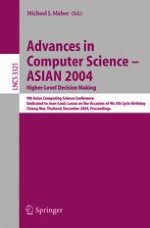2005 | Buch
Advances in Computer Science - ASIAN 2004. Higher-Level Decision Making
9th Asian Computing Science Conference. Dedicated to Jean-Louis Lassez on the Occasion of His 5th Birthday. Chiang Mai, Thailand, December 8-10, 2004. Proceedings
herausgegeben von: Michael J. Maher
Verlag: Springer Berlin Heidelberg
Buchreihe : Lecture Notes in Computer Science
